Key takeaways:
- Allyship requires active listening, recognizing privileges, and taking consistent action to support marginalized voices and instigate long-term change.
- Advocating for gender equality influences societal norms and empowers individuals to challenge injustices and promote reciprocal support.
- Effective strategies include advocating for equitable policies, mentoring, and creating safe spaces for dialogue to foster understanding and collaboration.
- Measuring the impact of allyship involves assessing tangible outcomes and utilizing storytelling to connect emotionally and inspire others in the movement.
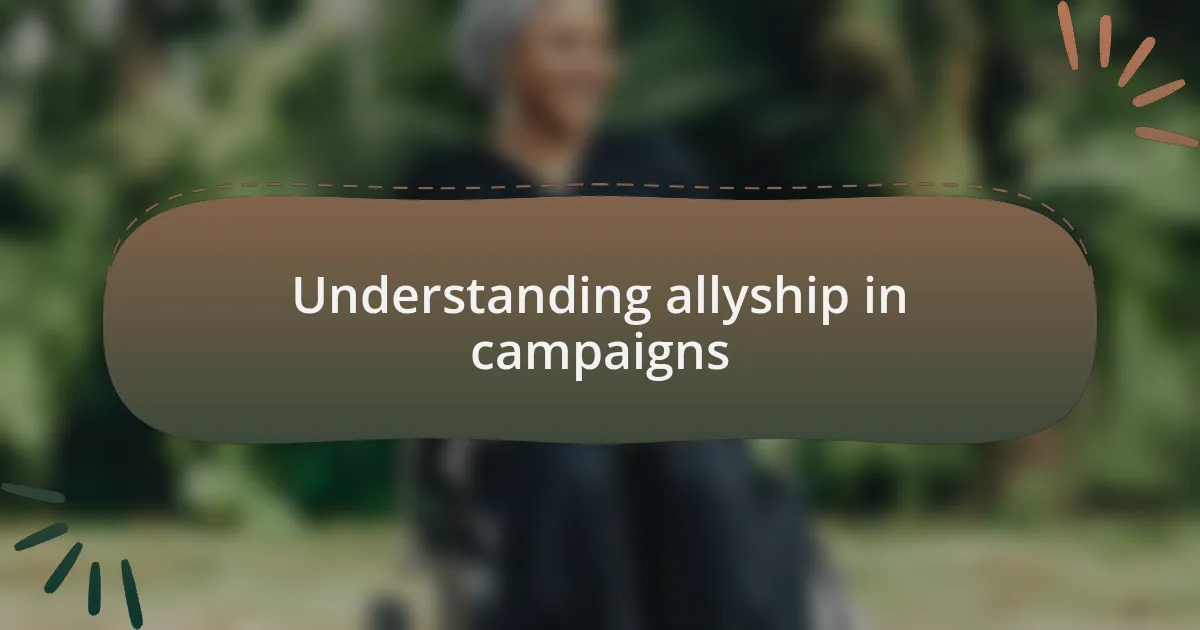
Understanding allyship in campaigns
Allyship in campaigns is about more than just support; it’s a commitment to actively engage in the struggle for gender equality. I remember attending a rally where I witnessed individuals from diverse backgrounds come together, amplifying marginalized voices instead of overshadowing them. It struck me then: how can we be true allies if we aren’t willing to listen first?
Understanding allyship also involves recognizing our own privileges. As someone who has navigated different spaces, I’ve learned that my experiences can sometimes shield me from the very issues I advocate against. This realization prompts a crucial question—how do we ensure that our advocacy doesn’t become performative?
Moreover, effective allyship requires consistent action. I’ve seen campaigns falter when support fades after the initial excitement wanes. This begs another question: what are we doing to sustain our commitment? For allyship to be meaningful, it has to translate into long-term strategies that create lasting change within communities.
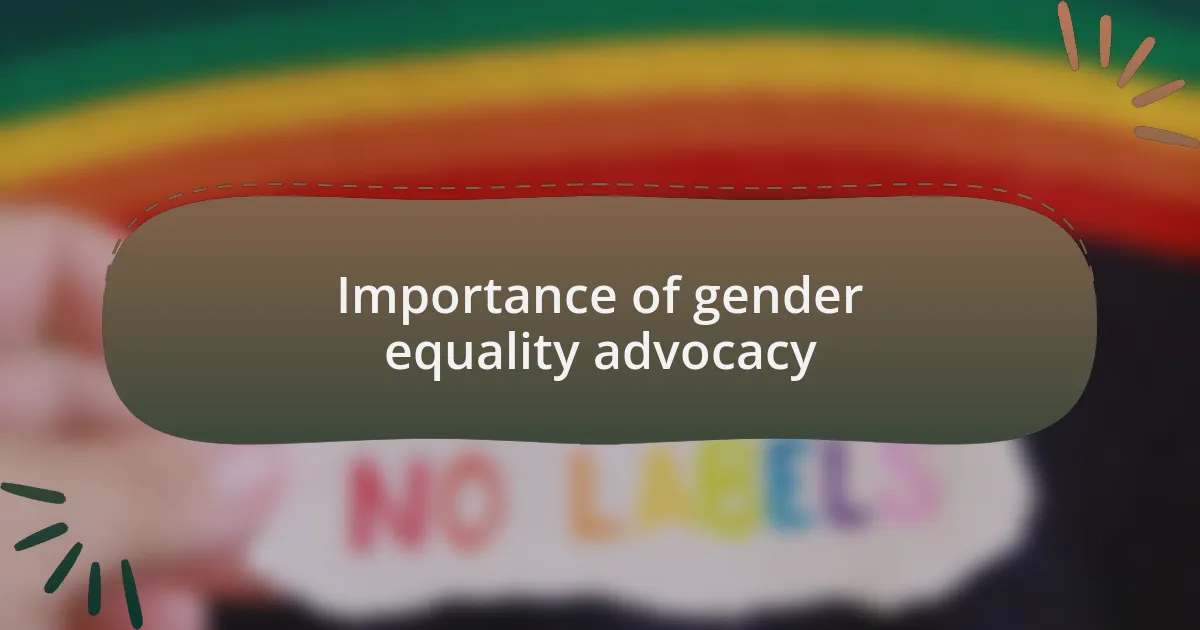
Importance of gender equality advocacy
Advocating for gender equality is essential because it lays the groundwork for a fair society. I’ve experienced firsthand how conversations around equality can shift the dynamics in communities, opening doors for people who have historically been marginalized. When everyone has an equal chance to succeed, we’re not just enriching individual lives but also strengthening the whole fabric of society.
The impact of gender equality advocacy is profound; it influences laws, workplace policies, and cultural norms. I recall a campaign where we pushed for equal pay legislation, and seeing the change in how women were treated in the workplace was incredibly rewarding. This made me ponder—how can we measure the effectiveness of our advocacy if we aren’t proactive in tracking these changes?
Moreover, gender equality advocacy empowers individuals to challenge injustice. I remember a friend who, inspired by our discussions, started a local initiative to support women in tech. Her courage made me reflect on my role in fostering other people’s bravery—how can we motivate others to take action when they feel powerless? In my view, the essence of advocacy lies in this reciprocal empowerment.
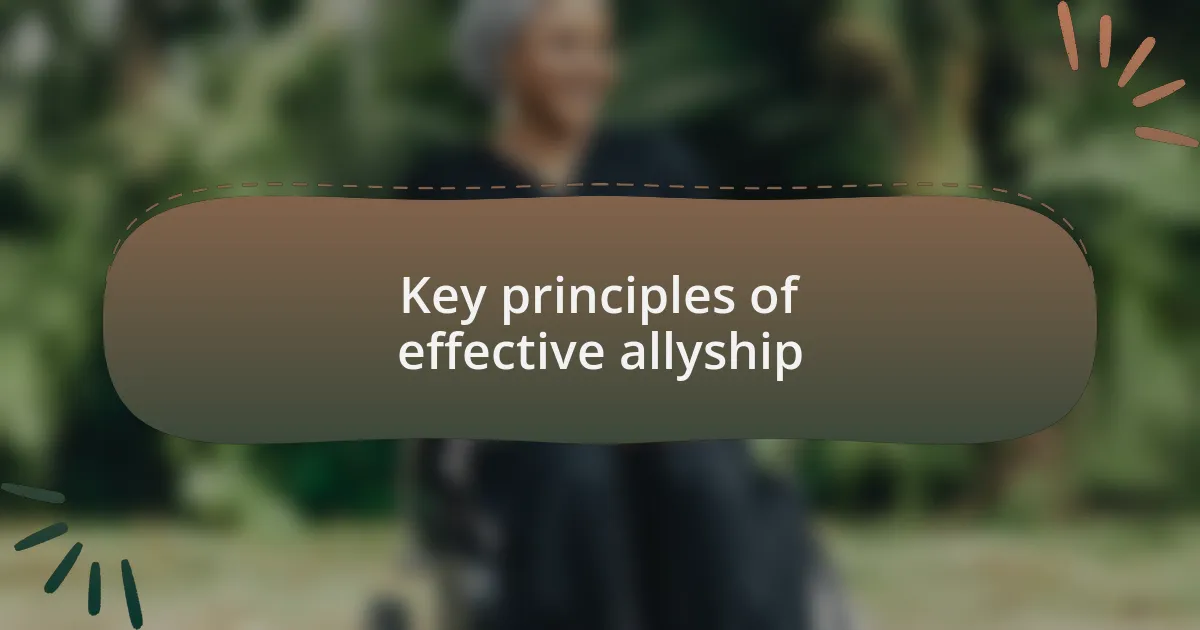
Key principles of effective allyship
When I think about effective allyship, one principle stands out: active listening. It’s about truly hearing the experiences and concerns of those we aim to support. I remember attending a workshop where a panel of women shared their stories about workplace discrimination. The room was silent, and it struck me how powerful it was just to listen. I realized that listening is the first step in understanding the complexities of their struggles.
Another essential principle is taking responsibility for our actions. There was a time when I unknowingly used language that marginalizes voices. When someone pointed it out, instead of getting defensive, I took that feedback to heart. It was a humbling experience that underscored how important it is for allies to acknowledge their missteps and learn from them. This journey of growth can deeply enhance our ability to be supportive.
Lastly, effective allyship involves speaking up, even when it’s uncomfortable. I once found myself in a team meeting where a colleague’s ideas were dismissed because of her gender. I hesitated at first, but I mustered the courage to advocate for her perspective. That moment taught me that voicing the value of diverse contributions can significantly shift team dynamics. I often ask myself, what would I want someone to do for me in that situation? Allyship is about extending that support actively.

Strategies for supporting gender equality
Supporting gender equality requires a multifaceted approach. One strategy I often advocate for is advocating for equitable policies within organizations. I recall a time when I worked on a committee tasked with reviewing our company’s maternity and paternity leave policies. It was eye-opening to see how small changes, such as implementing flexible schedules, completely transformed the workplace culture. How can we expect meaningful change without first assessing and recalibrating the foundational policies that govern our work environments?
Another crucial strategy involves mentorship and sponsorship. I remember being mentored by a senior female leader who took the time to share her insights and experiences. It wasn’t just about professional guidance; it was about building confidence in my abilities. Isn’t that what we all need? Someone who believes in us and actively helps us navigate our paths? As allies, we must invest our time and resources in uplifting those who may not have the same opportunities.
Lastly, one of the most impactful strategies is creating safe spaces for dialogue. I participated in a roundtable discussion where individuals from diverse backgrounds shared their experiences with gender bias. It was an emotional and enlightening experience. How might we do more of this in our communities? By fostering environments where honest conversations can happen, we not only validate each other’s feelings but also cultivate a deeper understanding of the challenges we face. It’s about breaking down barriers through empathy and shared stories.
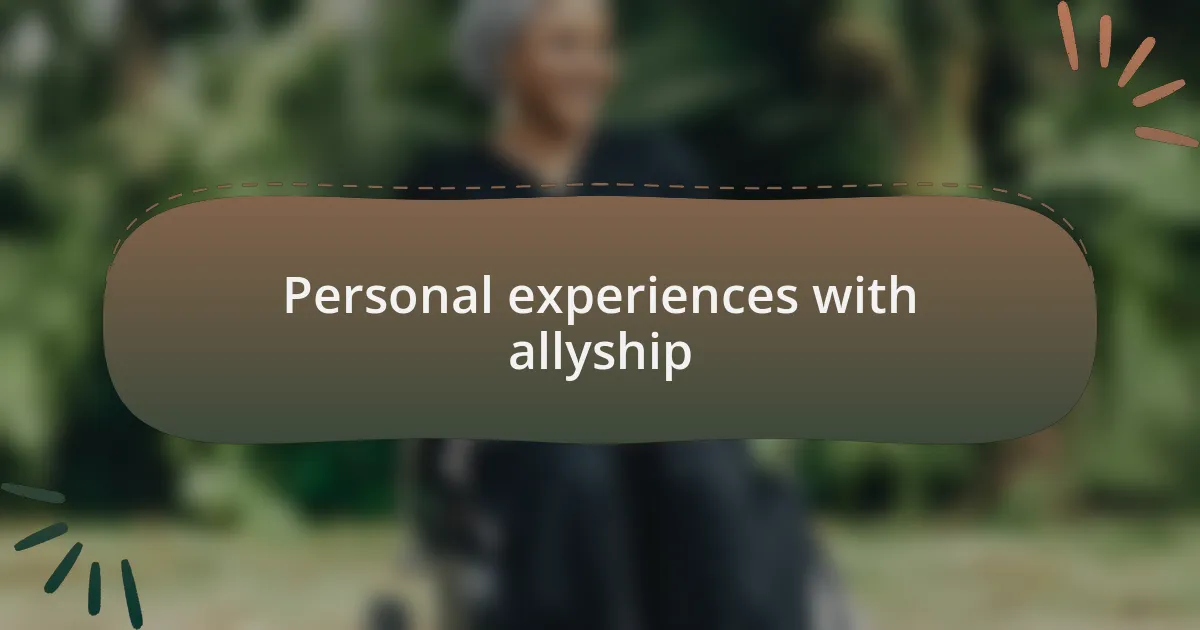
Personal experiences with allyship
Reflecting on my own journey, I think back to a powerful moment during a panel discussion on gender bias in leadership. I was seated next to a younger colleague who nervously shared her story of being overlooked for a project due to her gender. Seeing her vulnerability sparked a fierce protective instinct in me. I could feel the collective energy in the room shift, and I realized that by amplifying her voice, I was not just supporting her but also challenging the systemic issues that perpetuate inequities. Don’t we all deserve to be heard?
In another instance, I participated in a workplace training on allyship where we had to confront our own biases. It was uncomfortable, to say the least. I remember grappling with my emotions when I recognized how my own privileges had allowed me to sidestep difficult conversations about gender inequality. This experience was a crucial reminder that being an ally isn’t passive; it requires active engagement and a willingness to grow. How often do we take that leap into discomfort to foster change?
Most recently, I joined a community initiative aimed at empowering female entrepreneurs. One weekend, we hosted a workshop where participants shared their stories of resilience and ambition. What struck me was the palpable sense of camaraderie that formed among us. I found myself not just listening, but exchanging ideas and resources with women who faced similar challenges. This shared experience underscored the importance of allyship as a collective effort. Isn’t it incredible how supporting one another can pave the way for meaningful progress?
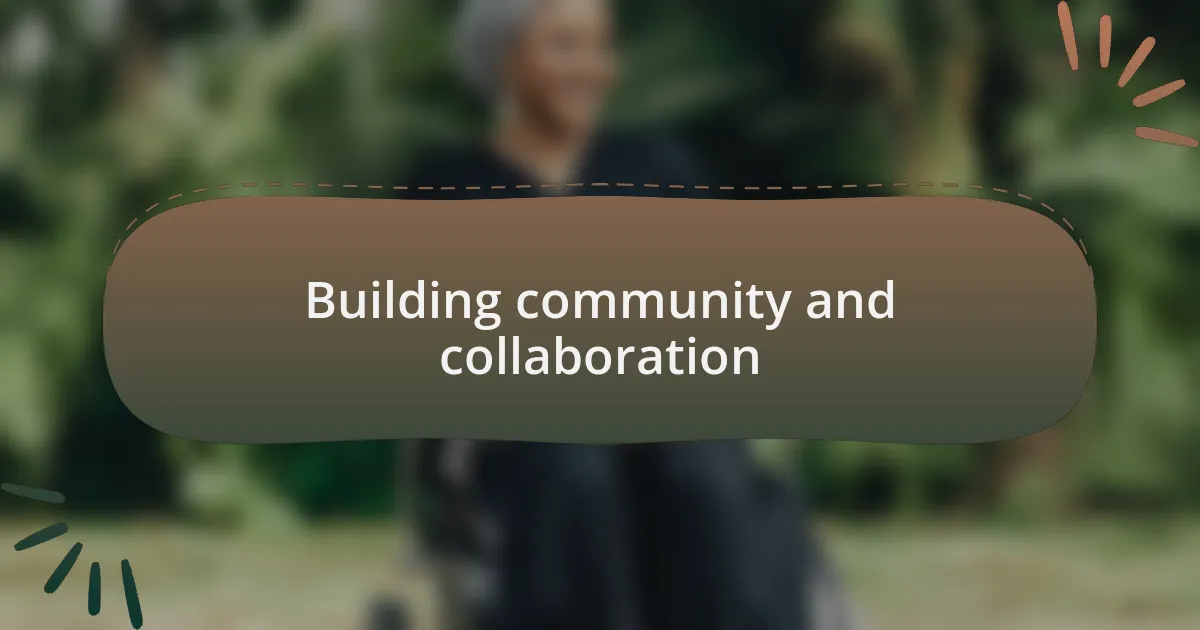
Building community and collaboration
Building a strong community requires intentional collaboration. I remember joining a local women’s group where we collectively brainstormed ideas to support each other’s ventures. It was inspiring to hear diverse perspectives as we cultivated an environment where each voice mattered. Isn’t it amazing how collaborative efforts can lead to innovative solutions that benefit everyone involved?
In another instance, I attended a networking event focused solely on supporting women of color in business. Collaborating with individuals from different backgrounds opened my eyes to unique challenges and opportunities. Sharing our narratives not only deepened our connections but also highlighted the importance of building bridges across various communities. How often do we seek out these enriching exchanges to expand our understanding and foster collective strength?
A striking memory for me was when we organized a community outreach event where we brought together local businesses and advocacy groups. I witnessed firsthand how combining our resources led to a larger impact than we could have achieved alone. The energy in that room was electric, fueled by our shared commitment to gender equality. This experience reinforced my belief that community-building isn’t just beneficial; it’s essential. What can we create together when we fully embrace collaboration?
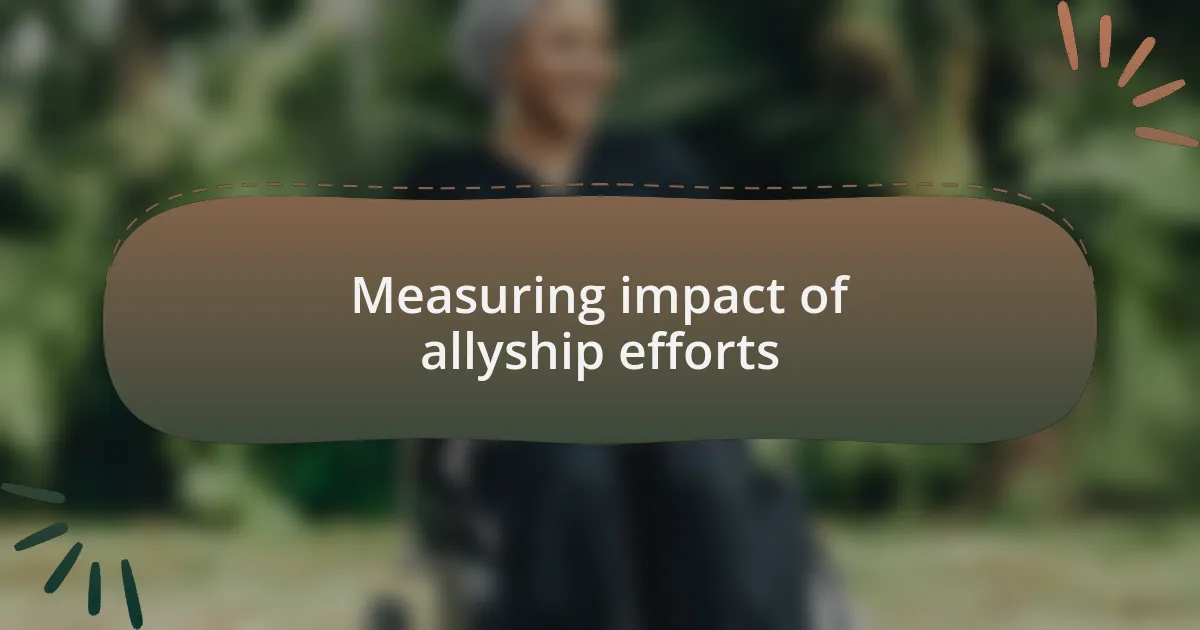
Measuring impact of allyship efforts
Measuring the impact of allyship efforts often begins with assessing the tangible outcomes of our campaigns. I recall attending a recent workshop on allyship, where we quantified our efforts through metrics like participant engagement and success stories. It was enlightening to see how numerical data could reveal shifts in attitudes and behaviors, emphasizing the effectiveness of deliberate actions in promoting gender equality.
When I participated in a campaign promoting women’s leadership, we utilized surveys before and after our initiatives to gauge changes in perceptions of female leaders. This method not only provided concrete evidence of growth but also highlighted areas needing further attention. Have you ever wondered how such feedback can shape future campaigns? It’s an eye-opening process that fosters continuous improvement and adaptability in our approaches.
In my experience, storytelling is another powerful tool for measuring the emotional impact of allyship efforts. One campaign I was involved in encouraged allies to share their journeys and the lessons learned along the way. The heartfelt testimonials resonated deeply, illustrating how the emotional connection can be just as significant as metrics. Isn’t it fascinating how these narratives can spark inspiration and encourage others to join the movement?